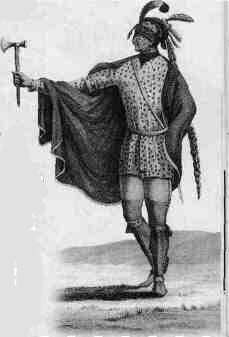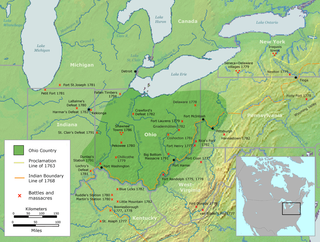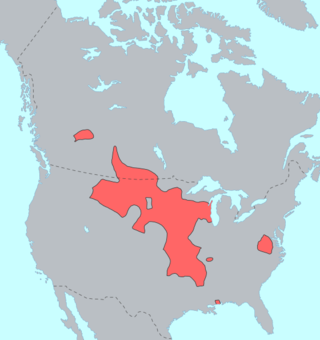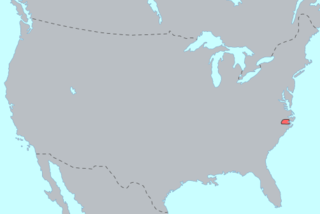Related Research Articles

The Illinois Confederation, also referred to as the Illiniwek or Illini, were made up of 12 to 13 tribes who lived in the Mississippi River Valley. Eventually member tribes occupied an area reaching from Lake Michicigao (Michigan) to Iowa, Illinois, Missouri, and Arkansas. The five main tribes were the Cahokia, Kaskaskia, Michigamea, Peoria, and Tamaroa. The spelling Illinois was derived from the transliteration by French explorers of iliniwe to the orthography of their own language. The tribes are estimated to have had tens of thousands of members, before the advancement of European contact in the 17th century that inhibited their growth and resulted in a marked decline in population.

The Iowa, also known as Ioway, and the Bah-Kho-Je or Báxoje, are a Native American Siouan people. Today, they are enrolled in either of two federally recognized tribes, the Iowa Tribe of Oklahoma and the Iowa Tribe of Kansas and Nebraska.

The Ohio Country was a name used for a loosely defined region of colonial North America west of the Appalachian Mountains and south of Lake Erie.

The Caddoan languages are a family of languages native to the Great Plains spoken by tribal groups of the central United States, from present-day North Dakota south to Oklahoma. All Caddoan languages are critically endangered, as the number of speakers has declined markedly due to colonial legacy, lack of support, and other factors.

The Western Siouan languages, also called Siouan proper or simply Siouan, are a large language family native to North America. They are closely related to the Catawban languages, sometimes called Eastern Siouan, and together with them constitute the Siouan (Siouan–Catawban) language family.

The Macro-Siouan languages are a proposed language family that includes the Siouan, Iroquoian, and Caddoan families. Most linguists remain unconvinced that these languages share a genetic relationship, and the existence of a Macro-Siouan language family remains a subject of debate.
Miami–Illinois, also known as Irenwee, is an indigenous Algonquian language spoken in the United States, primarily in Illinois, Missouri, Indiana, western Ohio and adjacent areas along the Mississippi River by the Miami and Wea as well as the tribes of the Illinois Confederation, including the Kaskaskia, Peoria, Tamaroa, and possibly Mitchigamea. The Myaamia (Miami) Nation of Oklahoma and the Miami Nation of Indians of the State of Indiana still practice and use their native heritage to teach young and old so they can keep their traditional language alive.

The Quapaw or Arkansas, officially the Quapaw Nation, is a U.S. federally recognized tribe comprising about 5,600 citizens. Also known as the Ogáxpa or “Downstream” people, their ancestral homelands are traced from what is now the Ohio River, west to the Mississippi River to present-day St. Louis, south across present-day Arkansas and eastern and southern Oklahoma. The government forcibly removed them from Arkansas Territory in 1834. The tribal capital is Quapaw, Oklahoma.

Siouan or Siouan–Catawban is a language family of North America that is located primarily in the Great Plains, Ohio and Mississippi valleys and southeastern North America with a few other languages in the east.
The Mosopelea, or Ofo, were a Siouan-speaking Native American people who historically lived near the upper Ohio River. In reaction to Iroquois Confederacy invasions to take control of hunting grounds in the late 17th century, they moved south to the lower Mississippi River. They finally settled in central Louisiana, where they assimilated with the Tunica and the Siouan-speaking Biloxi. They spoke the Ofo language, generally classified as a Siouan language.

The Manahoac, also recorded as Mahock, were a small group of Siouan-language Native Americans in northern Virginia at the time of European contact. They numbered approximately 1,000 and lived primarily along the Rappahannock River west of modern Fredericksburg and the Fall Line, and east of the Blue Ridge Mountains. They united with the Monacan, the Occaneechi, the Saponi and the Tutelo. They disappeared from the historical record after 1728 due of introduction of European diseases, which is Manahoac had no acquired immunity.

The Tutelo were Native American people living above the Fall Line in present-day Virginia and West Virginia. They spoke a dialect of the Siouan Tutelo language thought to be similar to that of their neighbors, the Monacan and Manahoac nations.

James Owen Dorsey was an American ethnologist, linguist, and Episcopalian missionary in the Dakota Territory, who contributed to the description of the Ponca, Omaha, and other southern Siouan languages. He worked for the Bureau of American Ethnology of the Smithsonian Institution from 1880 to 1895, when he died young of typhoid fever. He became known as the expert on languages and culture of southern Siouan peoples, although he also studied tribes of the Southwest and Northwest.

The Moneton were a historical Native American tribe from West Virginia. In the late 17th century, they lived in the Kanawha Valley near the Kanawha and New Rivers.
The Dhegihan languages are a group of Siouan languages that include Kansa–Osage, Omaha–Ponca, and Quapaw. Their historical region included parts of the Ohio and Mississippi River Valleys, the Great Plains, and southeastern North America. The shared Dhegihan (Degihan) migration history and separation story places them as a united group in the late 1600s near the confluence of the Ohio and Tennessee rivers which then moved westward towards the Missouri River, and separated into different bands. However, some oral traditions and archeological evidence indicate that Dhegihan speaking peoples may have migrated west out of the Ohio River Valley much earlier.

Tutelo, also known as Tutelo–Saponi, is a member of the Virginian branch of Siouan languages that were originally spoken in what is now Virginia and West Virginia in the United States.
The Cahokia were an Algonquian-speaking Native American tribe and member of the Illinois Confederation; their territory was in what is now the Midwestern United States in North America.

Woccon was one of two Catawban languages of what is now the Eastern United States. Together with the Western Siouan languages, they formed the Siouan language family. It is attested only in a vocabulary of 143 words, printed in a 1709 compilation by English colonist John Lawson of Carolina. The Woccon people that Lawson encountered have been considered by scholars to have been a late subdivision of the Waccamaw.

Stoney—also called Nakota, Nakoda, Isga, and formerly Alberta Assiniboine—is a member of the Dakota subgroup of the Mississippi Valley grouping of the Siouan languages. The Dakotan languages constitute a dialect continuum consisting of Santee-Sisseton (Dakota), Yankton-Yanktonai (Dakota), Teton (Lakota), Assiniboine, and Stoney.
The Nansemond language is an extinct language that was spoken by the Nansemond people of Virginia, United States.
References
- ↑ "Front Page". puffin.creighton.edu. 11 August 2014. Retrieved 18 May 2017.
- ↑ Koontz, John E. 1995. Michigamea as a Siouan language. Paper presented at the 15th annual Siouan and Caddoan Languages Conference, University of New Mexico - Albuquerque.